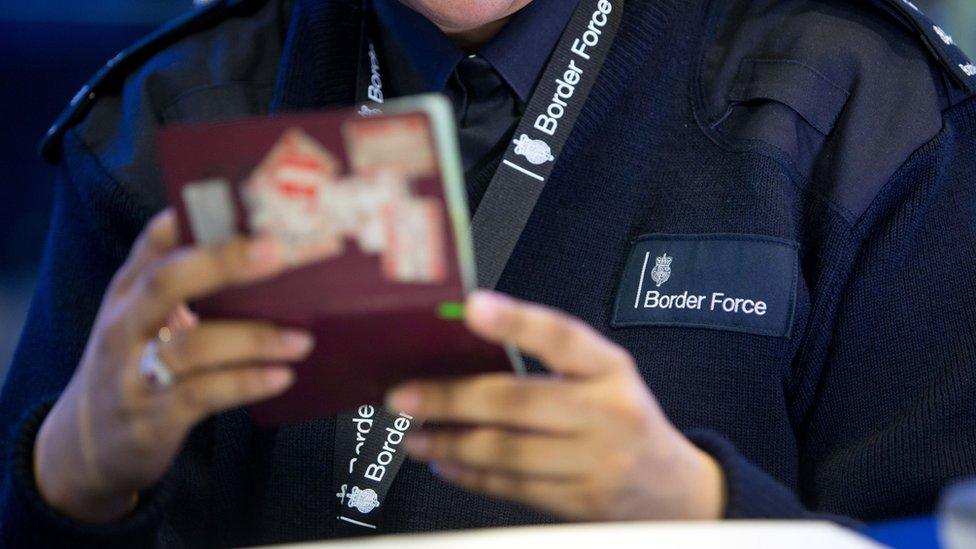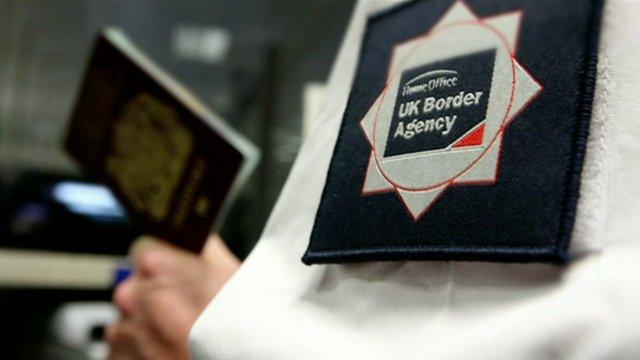Home Office criticised over £830m 'failed' borders scheme
- Published

The Home Office has been criticised for failing to complete a project to boost UK border security - despite spending at least £830 million on it.
The e-borders scheme was meant to collect and analyse data on everyone travelling to and from the UK before they arrive at ports and airports.
But the National Audit Office says checks remain "highly manual and inefficient", and IT systems outdated.
The Home Office says all UK arrivals are checked against watch lists.
The e-borders scheme has been dogged by problems since its launch in 2003, and in 2014, the head of the UK Border Force, Sir Charles Montgomery, told MPs it had been "terminated" in its current form.
By collecting advanced passenger information (API), such as passport numbers and nationalities, it was meant to allow officials to "export the border" by preventing people from embarking on journeys to the UK where they were considered a threat.
Eight years late
Among the report's key findings:
£830m was spent on the project between April 2006 and March 2015, with another £275m likely to be needed by March 2019
Among those costs was £150m on an out-of-court settlement paid after the original e-borders contract was cancelled
The project is not set to be finished until 2019 - eight years late
API was only collected from 86% of arrivals in September this year, despite the target being 100%
Moreover, API still is not available for most rail and ferry journeys
Only 20% of booking data - more comprehensive than API - is being collected. Again, the target is 100%.
The NAO said a database known as the Warning Index - designed to flag up known criminals or terrorists - was still being used eight years after it should have been retired.
While it has been upgraded, it is "still far from good" and suffers an average of two "high priority incidents a week".
These breakdowns include situations where part of the system is not available or performing too slowly to function, or where it is inaccessible at 30% or more control points at a port or airport.
The Home Office insisted contingency arrangements were in place for when those incidents occurred.

Analysis: Danny Shaw, BBC home affairs correspondent
This is a devastating critique of a project presented by the Home Office, first under Labour, as the key to securing Britain's borders. In fact, as the report reveals, the programme has been torpedoed by its ambition.
Collecting and assessing advance passenger information on more than 200 million journeys a year was always going to be hard task - involving co-ordinating the supply of data from 600 air, ferry and rail carriers and 30 government agencies.
Add in creaking computer systems, a high turnover of key staff and a draining legal dispute with the private contractor, and it's clear that ministers and officials over-reached themselves.
There's little doubt more advance passenger information is available now than in 2003, when the scheme was first developed, but the costs have risen hugely with some border checks still being conducted using scraps of paper.

The Warning Index operates alongside another system called semaphore, but the NAO said the failure to integrate them meant staff still had to check passports manually and consult printed A4 sheets when probing suspicious vehicle registrations.
Amyas Morse, head of the NAO, said e-borders had not "delivered value for money".
"Some valuable capabilities have been added to our border defences during the life of this project, though their efficiency is impaired by a failure to replace old IT systems," he added.
Keith Vaz, chairman of the Home Affairs Select Committee, described the report as a "devastating indictment" of the e-borders project.
"With the terrorism threat level currently at severe, a failure to properly cover millions of people entering the country without having passenger information in advance gives a green light to people who wish to come to the UK for illegal or dangerous activity," he said.

What are e-borders?
Launched in 2003, the scheme was originally meant to collect details from passenger lists of all people entering and leaving the UK
The US firm handed the £750m contract, Raytheon, was fired by the coalition in 2010
The e-borders contract was split in two with IBM and Serco given the job of getting a system in place at nine airports before the 2012 London Olympics
In 2014, the director general of the UK Border Force said "full e-borders capability", as originally envisaged, would not be achieved, but the checks and screening would be incorporated into a new programme.

Immigration Minister James Brokenshire said every passenger arriving in the UK was checked against a range of watch lists.
"The e-borders programme was set up under the Labour government and when that contract ended in 2010, our immediate priority was to invest in stabilising the crucial but old-fashioned systems, to tackle the fast-evolving terrorist, criminal and illegal immigration threats faced by the UK.
"The Border Systems Portfolio, in conjunction with a range of programmes across security and law enforcement, is working effectively to keep our citizens safe and our country secure."
- Published17 February 2015

- Published9 October 2013

- Published12 March 2014
